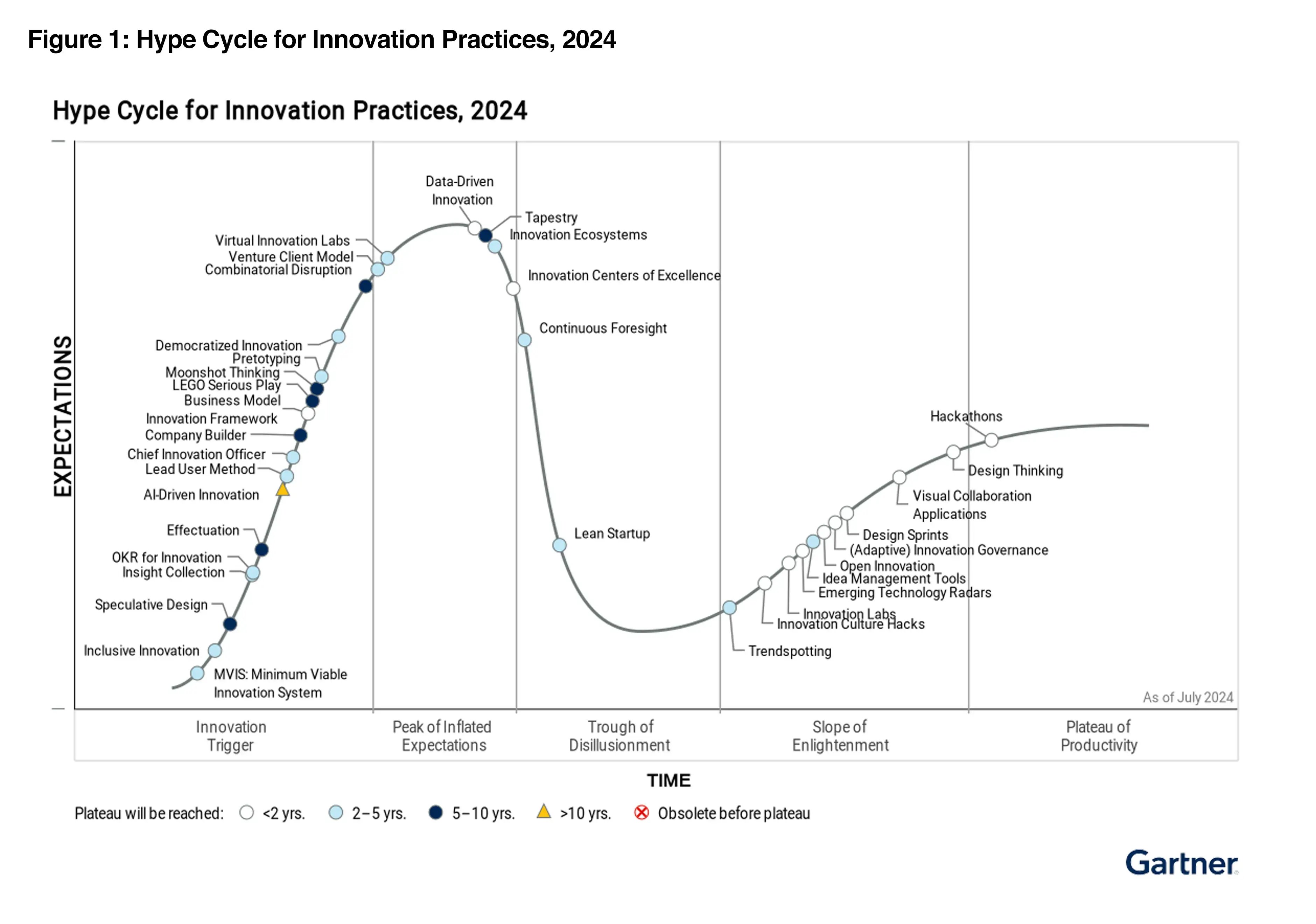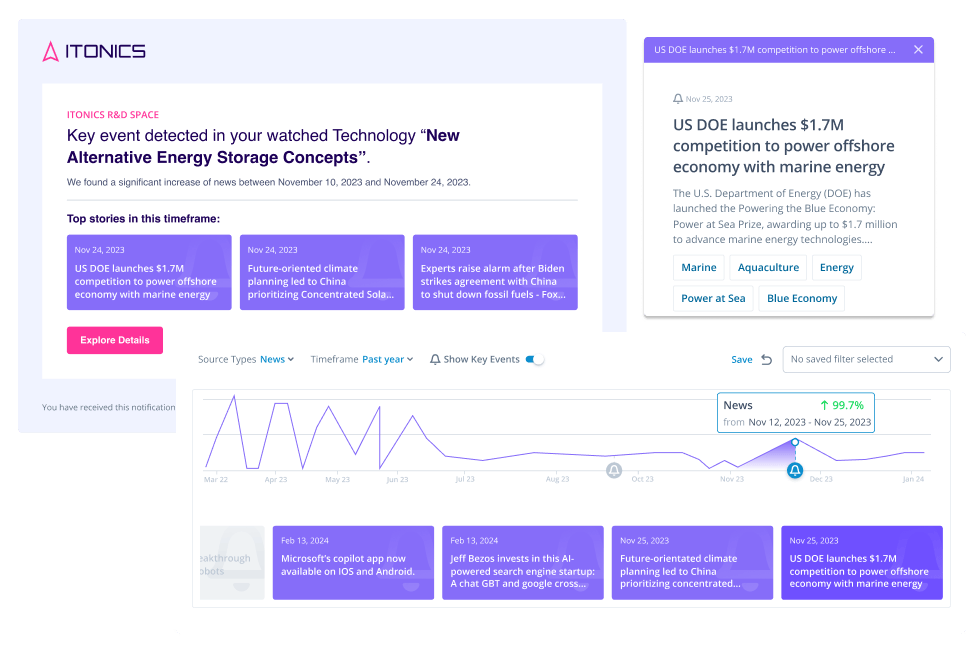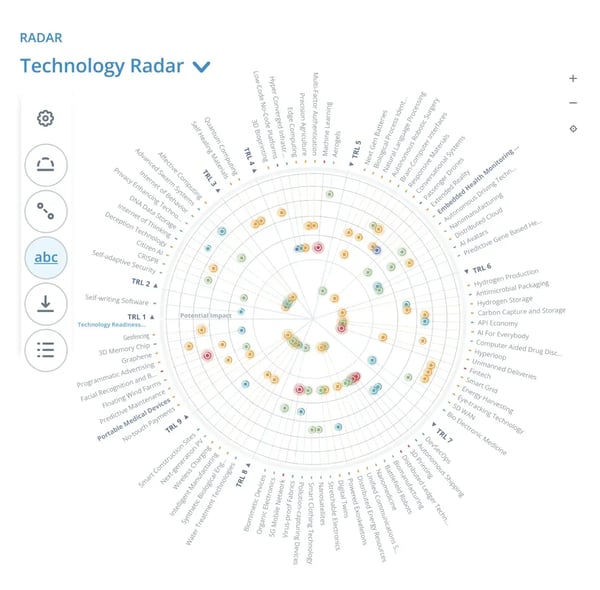With all the innovation methods available today, it can be challenging for business leaders to tell the difference between what is overhyped and what will actually benefit their company. Luckily, the Gartner® Hype Cycle™ for Innovation Practices provides an extensive assessment of 35 innovation practices.
How to interpret the Hype Cycle
Gartner plots innovation practices on a graph, where the y-axis indicates expectations and the x-axis shows time. From our perspective at ITONICS, innovation practices on the right side of the graph aren’t outdated; they’re reliable, and their value is adequately understood. So, while new methods on the left of the graph (e.g., speculative design and pretotyping) look promising, methods that have reached the “Plateau of Productivity” are a safer bet if you’re uncertain about where to invest your organization’s resources.
Gartner observes, "In many organizations, even techniques that have been around for decades, such as hackathons and innovation workshops, are only used intermittently — often driven by a single enthusiastic executive or manager. By clearly demonstrating the value of innovation techniques, executive leaders can embed them better into broader management practices and tools.”

ITONICS recognized as a Sample Vendor for 4 categories
Gartner recognized ITONICS as a Sample Vendor for continuous foresight, trendspotting, emerging technology radars, and idea management tools. Let’s take a closer look at developments in each topic area.
Continuous Foresight
At ITONICS, we see continuous foresight as essential for a company’s long-term survival. However, many large companies still prefer a more traditional market research approach.
According to Gartner, “Continuous foresight leverages the best practices of strategic/corporate foresight and futurism to continuously assess and evaluate business models and strategies, and determine how to adjust either or both to create future success. Continuous foresight is a discipline for identifying and assessing plausible futures using predictive, explorative and normative (backcasting) lenses. Continuous foresight will help support the process of anticipating and influencing a world of continual change.”
While we expect the hype around continuous foresight to decline in the short term, Gartner assesses that it offers high benefits and that the practice is emerging in maturity. This aligns with our view at ITONICS, where we see the workload and complexity of continuous foresight as an obstacle to its wider adoption. That’s why we’ve developed ITONICS Foresight to automate and centralize these foresight activities. Our clients use the software to accelerate opportunity discovery and benefit from AI-driven search capabilities, making it much less time-consuming to provide ongoing evidence of market shifts.

Trendspotting
Gartner has seen an increase in the number of technology innovation leaders, including CTOs and CIOs, looking to establish a trendspotting capability as part of their organization.
In our opinion, flawed approaches are slowing down trendspotting’s broader adoption as a standard innovation practice. Some organizations treat trendspotting as an informal, ad hoc activity. Information isn’t shared between departments, and there’s no coordinated cross-company response to threats on the horizon. If you don’t analyze the factors driving a trend, your company might miss the bigger picture and see trends as an inevitable bandwagon effect. To avoid being blindsided by future trends, teams must understand the factors shifting consumer needs and determine how to respond.
With the ITONICS Innovation OS, you can do comprehensive trend scouting, build a central trend database, and use visualizations to analyze drivers of change collaboratively. With this objective, many of our clients showcase the key trends affecting their company on a STEEP-segmented trend radar and a Rumsfeld Matrix (also known as “Known-Unknown Matrix”). This helps them identify white spots in their future awareness and select emerging topics for further exploration. In addition, they use our AI-enabled signals feed for real-time information on trends important to their industry, geography, and strategic focus areas.

Emerging Technology Radars
When innovation leaders need to visualize and assess potential technology investments, a good approach, in our opinion, is to use an emerging technology radar. Organizations use these radars to analyze and communicate what technologies to be aware of and potentially act on. This intuitive visualization tool creates a shared perspective of the technology landscape. Technologies that will soon impact the company’s business are shown close to the middle of the radar, while technologies that need to be monitored for future impact are displayed on the edge.
Gartner rates this practice as “adolescent” in maturity and currently in the Slope of Enlightenment. We expect Emerging Technology Radars to reach the “Plateau of Maturity” in two years when more organizations adopt this approach to make decisions about new technologies.
The Gartner report notes that “emerging technology trends can cause disruption, pose risks and/or create opportunities for the organization” and that “Radars are easily digestible visualization tools for planning and decision making to help leaders make decisions about how and when to act for technology adoption.” Also, “Radars are generally considered an annual deliverable, but if not updated more regularly, disruptive technologies may be missed.”
In our opinion, the ideal is not to use radars as an annual static report, but to treat radars as live reflections of team consensus, continuously updated with emerging technology information.
The ITONICS Radar is built for this purpose. You can use it to identify which emerging technologies are relevant to your company and inform leadership decisions. Evaluate technologies as a team, then visualize that aggregated collective intelligence on a radar to accelerate decision-making and action. Display radars in meetings with internal stakeholders to align the organization and steer a winning technology strategy.

Idea Management Tools
According to Gartner, idea management tools are currently at the early mainstream maturity phase with a market penetration of 20% to 50% of the target audience. According to Gartner, “Idea management tools help organizations manage the flow of ideas from initial concept generation to final value realization or commercial exploitation.”
The Gartner report also mentions that, “idea management tools support many aspects of the innovation process including stage-gate workflow automation to support structured decision making based on cost, risk and business impact.” In our opinion, purpose-built tools are better at scaling ideation, though generating ideas with standard workplace software is still possible. However, a notable benefit of using configurable workflows for idea management is that they guide the process and standardize submission quality to reduce administrative effort.
ITONICS Ideation streamlines the idea evaluation process and even lets you generate a board of seed ideas with the help of GenAI to act as a catalyst for human creativity. Our idea management tools save you time by automatically showing related ideas so that you can merge them and eliminate duplication of effort. Gamification features also boost participation through friendly competition that rewards idea contributors.

Other key practices in innovation
Gartner rates the benefit of each innovation practice as either low, moderate, high, or transformational. Here is our curated list of practices from the report that we believe become easier and more effective with the help of ITONICS software.
Transformational benefit
Business Model Innovation Framework
Gartner defines the business model innovation framework as “a scenario-planning foundation that enables organizations to foster technology-enabled innovations in the areas of customer experience (CX), value propositions, capabilities and financial models. It is often used in ideation and innovation workshops to create a new business model as a goal of digital business transformation.” We see the benefit of this practice at ITONICS and have put together this Ultimate Toolkit for Business Model Innovation as a guide.
Combinatorial Disruption
Gartner explains, "Combinatorial disruption happens when two or more disruptions overlap or influence one another to create a new, distinctly disruptive effect. Combinatorial disruptions emerge from the interaction or combination of multiple factors, signals, events, forces or disruptive trends.” Our recommendation at ITONICS is to use continuous foresight to identify external forces of change—such as new regulations or consumer expectations—to stay ahead of the competition.
Moonshot Thinking
Gartner describes moonshot thinking as a “big and bold approach to innovation that aims to tackle large-scale challenges by pursuing transformative solutions, rather than incremental improvements.” At ITONICS, we see the importance of moonshots in a balanced innovation portfolio to explore groundbreaking ideas that could create entirely new markets.
Tapestry
Tapestry is a method that “equips executive leaders to determine the interconnection of forces, disruptions, signals and trends across the areas of technological, political, economical, social/cultural, trust/ethics, regulatory/legal and environmental (TPESTRE), to enhance their strategic decision making.” says Gartner. Our view at ITONICS is that this expansion of the standard PESTEL model is a welcome methodology that will benefit from purpose-built foresight software.
AI-Driven Innovation
Gartner describes AI-driven innovation as “a process that harnesses the power of AI technologies to accelerate innovation. It helps organizations unlock groundbreaking inventions in specialized domains, such as new drugs and material science.” ITONICS believes AI can help innovators cut through the noise, stay ahead of market changes, and boost human creativity. That’s why we’ve incorporated AI into ITONICS software to help companies innovate and grow.
High benefit practices
Data-Driven Innovation
Gartner states that data-driven innovation involves “the use of data and analytics to develop or foster new products, processes, organizational methods, and markets.” It is valuable because it “provides a more objective and pragmatic way to ideate or evaluate innovation ideas, leveraging data versus perception, eloquence or authority when human intervention is required to decide on the best innovation ideas or design patterns.” At ITONICS, we’ve developed the Innovation OS as a single point of truth where organizations can collect, organize, and analyze innovation-related data. With our range of visualization tools, you can make sense of your data and inform strategic decision-making.
Open Innovation
Making the case for open innovation, Gartner says, “In a world of abundant knowledge and instant information mobility, companies cannot rely on the notion that enough innovative people work for them, and that good ideas and perspectives only come from within. Nor should they assume that they possess the resources to exploit all their ideas internally. Innovation today must go beyond the boundaries of the individual organization so that talent and inspiration can be leveraged more widely.” ITONICS sees open innovation as essential for companies that want to stay ahead of the curve. Multinational engineering company Bosch is using ITONICS as an open innovation platform, which has yielded 1000+ submissions from startups, universities, and other experts.
Democratized Innovation
Gartner warns, "The potential for increasing autonomy and opacity from democratized innovation can pose risks to CIOs and IT departments, particularly regarding security, interoperability and considerations around nonfunctional requirements for innovation scaling and adoption.” At ITONICS, we recommend using a centralized platform to manage your technology portfolio and optimize your software inventory. Without proper governance, different departments may use various applications and technologies inefficiently, duplicating costs and preventing cross-departmental collaboration.
Innovation Ecosystems
According to Gartner, “Many digital business models are ecosystem-oriented, such as smart cities, healthcare, smart homes, and agriculture. Innovations in such areas often use ecosystems, especially when an individual organization might lack the skills, resources, or information to fully develop an idea. Such ecosystems can span startups, academics, vendors and competitors.” ITONICS sees the benefit of innovation ecosystems because they enable organizations to reach beyond traditional boundaries. Read our Ultimate Guide to Open Innovation to know what common challenges to address when building an innovation ecosystem.
Insight Collection
Gartner explains that “Insight collection serves as the Innovation Trigger in a collaborative way by calling for solutions, trends and customer feedback. Innovation that begins at idea collection is overweighted with self-interest, attaches to ego, and is too singularly focused to truly thrive in an enterprisewide innovation process.” That’s why ITONICS recommends doing collaborative rating of foresight intelligence to gain consensus on the forces affecting your company before proceeding with idea generation.
Venture Client Model
Gartner says, “The venture client model (VCM) is less complicated and faster than joint venture or venture capital (VC) vehicles for working with startups. It takes away many legal steps and due diligence activities. The financial efforts are lower and an attractive option for innovation teams with tight budgets.” At ITONICS, we’ve developed software that streamlines the venture clienting process. You can use ITONICS Ideation to define the challenges faced by your business units and then receive startup solution submissions on one platform.
Moderate benefit practices
(Adaptive) Innovation Governance
Gartner warns, "Organizations that are unable to establish the appropriate innovation governance mechanisms early are more at risk of their innovation efforts floundering due to a lack of agility and the ability to explore and achieve a timely and successful outcome. Moreover, there has been a push toward a more democratized delivery of innovation, meaning business and IT are co-leading and co-delivering innovation, prompting co-governing.” ITONICS recommends using an innovation governance framework template to specify the objectives, responsibilities, accountability, and coordination of innovation activities. This can help clarify expectations for teams and elevate their performance.
Hackathons
Gartner describes Hackathons as “a competitive design activity that involves developing a prototype or app, usually in one to two days. Assigned or self-selected teams work in parallel on a goal or challenge, and come together at a fun final event to pitch and compete against each other.” At ITONICS, we see the power of the crowd in problem-solving. Our software supports open innovation challenges with ITONICS Ideation functioning as a unified platform for idea submissions.
OKR for Innovation
Gartner explains that establishing “OKR for innovation sets innovation as a high-priority objective in line with business growth opportunities. Further, cascading OKR across stakeholders further defines everyone’s role in innovation and clearly assigns contribution.” At ITONICS, we see OKR as a useful goal-setting framework that you could incorporate into the KPIs of an innovation mandate to secure board buy-in. You can even customize dashboards in ITONICS Portfolio to highlight the status of OKRs.
Virtual Innovation Labs
Gartner provides this definition: “A virtual innovation lab is a digital environment for collaboration, ideation, experimentation and execution of new ideas that generate business value. It offers innovators an opportunity to collaborate with global talent, yet work independently in their remote locations.” In our view, the ITONICS Innovation OS is especially suited for this type of global collaboration. Organizations can use it as a central platform to manage new ideas and connect the dots from strategy to execution.
The end-to-end innovation solution
No matter your use case, we believe the ITONICS Innovation OS is the most comprehensive solution for end-to-end innovation. A major benefit of choosing ITONICS (compared to stand-alone tools for continuous foresight, tech management, trendspotting, and ideation) is how our software integrates strategic portfolio management and project roadmaps. If reading the Gartner® Hype Cycle™ for Innovation Practices has expanded the wishlist of what your organization wants to adopt, we think ITONICS can be your one-stop shop. Book a demo today to see how ITONICS can upgrade innovation at your company.
Disclaimer
Gartner, Hype Cycle for Innovation Practices, 2024, Peter Skyttegaard, et al, 8 July 2024
GARTNER is a registered trademark and service mark of Gartner, Inc. and/or its affiliates in the U.S. and internationally, and HYPE CYCLE is a registered trademark of Gartner, Inc. and/or its affiliates and are used herein with permission. All rights reserved.
Gartner does not endorse any vendor, product or service depicted in its research publications, and does not advise technology users to select only those vendors with the highest ratings or other designation. Gartner research publications consist of the opinions of Gartner’s research organization and should not be construed as statements of fact. Gartner disclaims all warranties, expressed or implied, with respect to this research, including any warranties of merchantability or fitness for a particular purpose.




